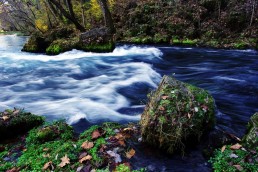Peace and Mystery Flows from Emanating Springs
Water that suddenly appears, whether it trickles, rushes or roars from the ground, is a fascinating natural phenomena called “springs.” The water is usually cold, and glistens with a pure brilliance and emanates as if from some mysterious source. These are the “architects” of subterranean caves, and the parents of rivers and streams. But most of all, they are peaceful places that inspire spiritual serenity.
Flowing water moves me in profound ways, and I’ve spent considerable time floating on the currents of freestone streams as they carve their way through hills and mountains. I’ve captured the smallmouth bass and trout, but when I think about it, it is not just the fish I see, but also the mountains as the “muscles” and the streams as the “veins” of the living world in the peak of its physical shape.
Often, when I pause from paddling or go to rest on a rock on the side of a stream, I realize the deeper significance of why I’m drawn to outdoor pursuits.
But when I happen upon a quiet spring, it’s different—all of life’s problems drain from me and I find myself sitting in quiet reverence and just watch the water roll. I’ve always been fascinated by springs, but my appreciation of them grew when I lived off the land in one of the most remote, rugged reaches of the Ozark Mountains.
No other area in the world contains more natural springs of first magnitude—over 65 million gallons a day flow upward and out from aquifers and the rock. Maybe I was drawn there to become a modern-day mountain man in the first place because of the abundance of these springs.
The larger springs form the headwaters of rivers, such as Montauk Springs, form the headwaters of the Current River. Others, such as Meramec Spring on the Maramec River, Greer Spring on the Eleven Point River and Rainbow Springs on the North Fork of the White River where I lived, double the size of what already are respectable flows.
Over the years I’ve visited and photographed the major springs of Missouri, and out of the whole bunch, Greer Spring is the most impressive. For one thing, it is isolated; to see it you must hike into the wilderness for about a mile from Highway 19. The spring emerges dramatically from the head of a box canyon and immediately tumbles rapidly down the narrow and steep ravine for a mile where it joins the Eleven Point River. The water is rapid and the noise is intense, so to be heard by someone, even at your shoulder, you must yell. This is the most rugged, pure example of nature I know.
These waters rushing from the ground have been studied extensively in Missouri. By pouring harmless dyes into various sinkholes and such, results from studies have determined that the recharge area of a spring is often drawn from a 200-square-mile area and that the water travels underground for weeks before erupting from the rocks or the mouth of a cave.
Large-volume springs are impressive, indeed, but I’m especially fond of smaller springs tucked away in remote places where tourists never tread.
If you happen to find one of these mysterious outlets, take a little time out to watch it flow. I don’t know where the one I found recently came from, but I do know where it took me.
Ron Kruger has been communicating the outdoor experience for over four decades. He has worked as a full-time guide for trout on the North Fork, for crappies and bass on Kentucky Lake and for smallmouths on the Current River. He has served as editor of three outdoor magazines, and owns a patent on a fly/lure called the Desperate Diver.
MWO
SHARE THIS POST
Did you enjoy this post?
You can be among the first to get the latest info on where to go, what to use and how to use it!
Ron Kruger
Ron Kruger has been communicating the outdoor experience for more than four decades. He has worked as a full-time guide for trout on the North Fork, for crappies and bass on Kentucky Lake and for smallmouths on the Current River. He has served as editor of three outdoor magazines, and owns a patent on a fly/lure called the Desperate Diver.




